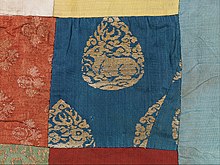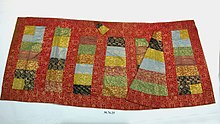
Patchwork or "pieced work" is a form of needlework that involves sewing together pieces of fabric into a larger design. The larger design is usually based on repeating patterns built up with different fabric shapes. These shapes are carefully measured and cut, basic geometric shapes making them easy to piece together.

A quilt is a multi-layered textile, traditionally composed of two or more layers of fabric or fiber. Commonly three layers are used with a filler material. These layers traditionally include a woven cloth top, a layer of batting or wadding, and a woven back combined using the techniques of quilting. This is the process of sewing on the face of the fabric, and not just the edges, to combine the three layers together to reinforce the material. Stitching patterns can be a decorative element. A single piece of fabric can be used for the top of a quilt, but in many cases the top is created from smaller fabric pieces joined, or patchwork. The pattern and color of these pieces creates the design.

Cheongsam or zansae, also known as the qipao and sometimes referred to as the mandarin gown, is a Chinese dress worn by women which takes inspiration from the qizhuang, the ethnic clothing of the Manchu people. The cheongsam is most often seen as a longer, figure-fitting, one piece garment with a standing collar, an asymmetric, left-over-right opening and two side slits, and embellished with Chinese frog fasteners on the lapel and the collar. It was developed in the 1920s and evolved in shapes and design over years. It was popular in China from the 1920s to 1940s, overlapping with the Republican era, and was popularized by Chinese socialites and high society women in Shanghai. Although the cheongsam is sometimes seen as traditional Chinese clothing, the cheongsam continues to evolve with times as it responds to the contemporary modern life.
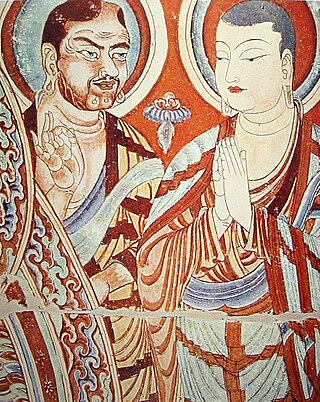
Kāṣāya are the robes of fully ordained Buddhist monks and nuns, named after a brown or saffron dye. In Sanskrit and Pali, these robes are also given the more general term cīvara, which references the robes without regard to color.

A bojagi is a traditional Korean wrapping cloth. Bojagi are typically square and can be made from a variety of materials, though silk or ramie are common. Embroidered bojagi are known as subo, while patchwork or scrap bojagi are known as chogak bo.

Zhiduo, also known as zhishen when it is decorated with outside pendulums, and haiqing, refers to two types of traditional changyi or paofu which were worn as outer robes by men in the broad sense; i.e. the casual zhiduo in Hanfu and the priests’ zhiduo, in the broad sense. As a specific term, the zhiduo refers to the former. The zhiduo was also called daopao by Wang Zhishen in the Ming dynasty although the daopao refers to another kind of paofu. Nowadays, the haiqing is sometimes referred as daopao. In present days Taiwan, the haiqing is also worn by the Zhenyi Taoist priests. The term "haiqing" can also be a specific term which refers to the long black or yellow robe worn by Buddhist monks.
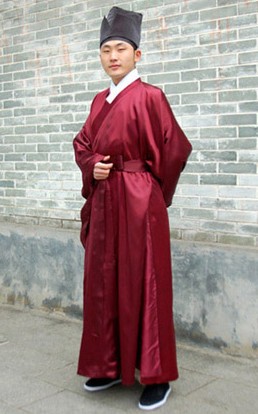
Daopao, also known as xuezi when used as a Xifu during Chinese opera performances, and deluo when it is blue in colour, is a traditional form of paofu in Hanfu and is also one of the most distinctive form of traditional clothing for the Han Chinese. The daopao was one of the most common traditional form of outer robe worn by men. Daopao literally means "Taoist robe"; however, despite its name, the daopao were and is worn by men, and did not imply that its wearer had some affiliation to taoism. The daopao can be dated back to at least the Ming dynasty but had actually been worn since the Song dynasty. Initially the daopao was a form of casual clothing which was worn by the middle or lower class in the Ming dynasty. In the middle and late Ming, it was one of the most common form of robes worn by men as casual clothing. The daopao was also a popular formal wear by the Ming dynasty scholars in their daily lives. It was also the daily clothing for the literati scholars in the Ming dynasty. In the late Ming, it was also a popular form of clothing among the external officials and eunuchs sometimes wore it. The daopao was also introduced in Korea during the Joseon period, where it became known as dopo and was eventually localized in its current form.
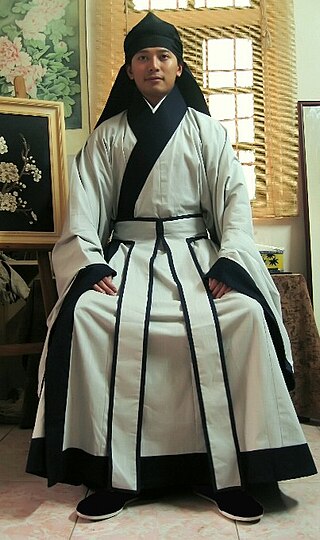
Shenyi, also called Deep garment in English, means "wrapping the body deep within the clothes" or "to wrap the body deep within cloth". The shenyi is an iconic form of robe in Hanfu, which was recorded in Liji and advocated in Zhu Xi's Zhuzi jiali《朱子家禮》. As cited in the Liji, the shenyi is a long robe which is created when the "upper half is connected to the bottom half to cover the body fully". The shenyi, along with its components, existed prior to the Zhou dynasty and appeared at least since the Shang dynasty. The shenyi was then developed in Zhou dynasty with a complete system of attire, being shaped by the Zhou dynasty's strict hierarchical system in terms of social levels, gender, age, and situation and was used as a basic form of clothing. The shenyi then became the mainstream clothing choice during the Qin and Han dynasties. By the Han dynasty, the shenyi had evolved into two types of robes: the qujupao and the zhijupao. The shenyi later gradually declined in popularity around the Wei, Jin, and Northern and Southern dynasties period. However, the shenyi's influence persisted in the following dynasties. The shenyi then became a form of formal wear for scholar-officials in the Song and Ming dynasties. Chinese scholars also recorded and defined the meaning of shenyi since the ancient times, such as Zhu Xi in the Song dynasty, Huang Zongxi in the Ming dynasty, and Jiang Yong in the Qing dynasty.
Dragon robes, also known as gunlongpao or longpao for short, is a form of everyday clothing which had a Chinese dragon, called long (龍), as the main decoration; it was worn by the emperors of China. Dragon robes were also adopted by the rulers of neighbouring countries, such as Korea, Vietnam, and the Ryukyu Kingdom.

Hanfu are the traditional styles of clothing worn by the Han Chinese. There are several representative styles of hanfu, such as the ruqun, the aoqun, the beizi and the shenyi, and the shanku.

Shuitianyi, also known as “paddy field garment”, "Shuitian clothing", or "rice-paddy robe", is a non-religious Chinese patchwork gown which was made and worn by women in China during the Ming dynasty and Qing dynasty; it was made by using many pieces of fabric sewn together ; the clothing reflected the era’s tendency towards fashion novelty during the Ming dynasty.

Paofu, also known as pao for short, is a form of a long, one-piece robe in Hanfu, which is characterized by the natural integration of the upper and lower part of the robe which is cut from a single fabric. The term is often used to refer to the jiaolingpao and the yuanlingpao. The jiaolingpao was worn since the Zhou dynasty and became prominent in the Han dynasty. The jiaolingpao was a unisex, one-piece robe; while it was worn mainly by men, women could also wear it. It initially looked similar to the ancient shenyi; however, these two robes are structurally different from each other. With time, the ancient shenyi disappeared while the paofu evolved gaining different features in each succeeding dynasties; the paofu continues to be worn even in present day. The term paofu refers to the "long robe" worn by ancient Chinese, and can include several form of Chinese robes of various origins and cuts, including Changshan,Qipao, Shenyi,Tieli, Zhisun, Yesa.

Jisün, also known as zhisunfu or Zhisun, zhixun, jixun, zhama or Jisun, was a very important male Mongol garment during the Yuan dynasty. They were also known as Mongol "robes of honour" (khil'at). The zhisun was a form of ceremonial clothing, which was worn during the jisün banquets, which were the most important ceremony of the Yuan dynasty court. The zhisun were made of textile woven with gold and silk of one colour. In China, the zhisun was introduced during the Yuan dynasty and was inherited by the Han Chinese during the Ming dynasty. In both the Yuan and Ming dynasty, the zhisun is a single-coloured court robe. The zhisun is a type of Mongol terlig.

Terlig, also known as tieli or bianxianao or Yaoxianao[zi] in Chinese, or commonly referred as Mongol dress or plait-line robe, is an archetypal type of Mongol clothing for men.

Mamianqun, also known as mamianzhequn, sometimes simply referred as 'apron', a generic term in English to refer to any Chinese-style skirt, or 'paired apron' in English although they are not aprons as defined in the dictionary, is a type of qun, a traditional Chinese skirt worn by the Han Chinese women as lower garment item in Hanfu and is one of the main representatives of ancient Chinese-style skirts. It originated in the Song and Liao dynasties and became popular due to its functionality and its aesthetics style. It continued to be worn in the Yuan, Ming, and Qing dynasties where it was a typical style of skirt for women and was favoured for its unique aesthetic style and functionality. Following the fall of the Qing dynasty, the mamianqun continued to be worn in the Republic of China, and only disappeared in the 1920s and 1930s following the increased popularity of the cheongsam. As a type of xifu, Chinese opera costumes, the mamianqun maintains its long tradition and continues to be worn nowadays. In the 21st century, the mamianqun regained popularity with the emergence of the Hanfu movement. The mamianqun has experienced various fashion changes throughout history. It was typically paired with ku, Chinese trousers and Chinese jackets, typically either the ao or gua.

Ucinaasugai, also known as Ryusou and referred as ushinchi in Okinawan, is the traditional dress of the Ryukyuan people. Ryusou is a form of formal attire; it is customary to wear it on occasions such as wedding ceremony and the coming-of-age ceremony. The ryusou became popular during the Ryukyu Kingdom period. It was originally worn by the members of the royal family and by the nobles of Ryukyu Kingdom. The Ryukyu Kingdom was originally an independent nation which established trade relationship with many countries in Southeast Asia and East Asia; they held their relationship with China as especially important. The development of the ryusou was influenced by both the hanfu and the kimono, demonstrating a combination of Chinese and Japanese influences along with local originality.

Daojiao fushi, also known as Taoist clothing, are religious clothing and adornment worn by devotees and practitioners of Taoism, an indigenous religion and life philosophy in China. Chinese culture attaches great importance to "cap and gown" are seen as important signs of levels of etiquettes; it is also a visible marker of the Taoist identity. Taoist ritual garments (sometimes referred as daoyi are forms of ritual clothing. These clothing worn by the Taoist priests are inherited from the Han Chinese traditional clothing and holds clear Taoist cultural meaning. When performing rituals and important rituals, Taoist priests wear ceremonial attires which appear to be aligned with elements of Chinese cosmology; these ceremonial attires are therefore strong spiritual intermediaries acting on the part of the Taoist devotees community. Different forms of clothing will be worn by Taoist priests in accordance to ritual types and obvious distinctions are found in the attire of Taoist priests based on their different positions to the altar. There were also codes which would stipulate the appropriate Taoist attire to be worn during both ritual performance and when being off duty.
Chinese auspicious ornaments in textile and clothing refers to any form of Chinese auspicious ornaments, which are used to decorate various forms of Chinese textile and clothing, fashion accessories, and footwear in China since the ancient times. Chinese auspicious ornaments form part of Chinese culture and hold symbolic meanings. In ancient China, auspicious ornaments were often either embroidered or woven into textile and clothing. They are also used on religious and ritual clothing and in Xifu, Chinese opera costumes. Auspicious symbols and motifs continue to be used in present day China in industries, such as home textiles and clothing; they are also used in modern design packaging and interior design. Some of these Chinese auspicious ornaments were also culturally appropriated by European countries during the era of Chinoiserie, where they became decorative patterns on fashionable chinoiserie fashion and textiles.

Baijiayi, also known as baijiapao and sometimes referred as One hundred families robe, Hundred-Families robe, or One hundred families clothing in English, is a form of Chinese patchwork jacket, particular for male children. The baijiayi is used as a protective talisman for children. It is a traditional Han Chinese custom garment, which has been passed down for centuries.
